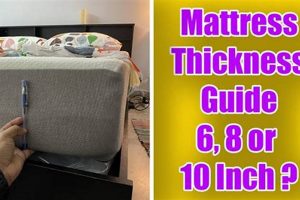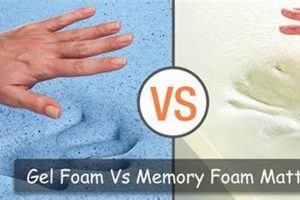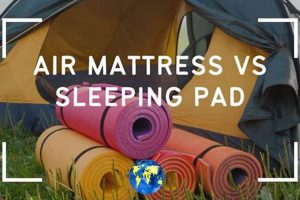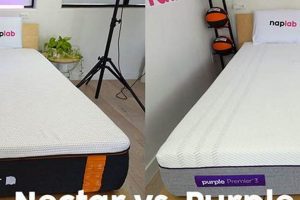The comparison of different mattress types is a common consideration for individuals seeking to improve sleep quality. Two notable options frequently evaluated are mattresses employing a unique grid design and those constructed with primarily memory foam layers. Understanding the characteristics of each can assist consumers in making informed purchasing decisions.
Selecting the appropriate mattress contributes significantly to overall well-being. Factors such as spinal alignment, pressure relief, and temperature regulation are influenced by mattress construction and material properties. Historically, advancements in sleep technology have led to diverse mattress designs, each offering distinct advantages and disadvantages.
Therefore, a detailed examination of these two mattress categories, focusing on construction, firmness, support, and other relevant attributes, is warranted. This analysis will provide a framework for evaluating which mattress may be best suited to individual needs and preferences.
Considerations for Mattress Selection
Selecting a mattress requires careful consideration of individual needs and preferences. Factors such as sleeping position, body weight, and desired firmness level should all be taken into account when evaluating different options.
Tip 1: Evaluate Sleeping Position: Individuals who sleep on their side generally benefit from mattresses that offer enhanced pressure relief at the shoulders and hips. Stomach sleepers typically require a firmer surface to prevent excessive sinking and maintain spinal alignment. Back sleepers often find a medium-firm mattress provides the optimal balance of support and comfort.
Tip 2: Assess Body Weight: Heavier individuals may require a mattress with increased support and durability to prevent sagging and ensure proper spinal alignment. Lighter individuals may find softer mattresses more comfortable, as they conform more readily to the body’s contours.
Tip 3: Determine Firmness Preference: Mattress firmness is subjective, but generally ranges from extra-soft to extra-firm. Trial and error may be necessary to determine the ideal firmness level. Reading customer reviews and consulting with sleep experts can provide valuable insights.
Tip 4: Research Construction and Materials: Different mattress types, such as innerspring, memory foam, and hybrid, offer varying levels of support, comfort, and durability. Understanding the properties of each material can help inform the selection process. Consider factors such as motion isolation, temperature regulation, and off-gassing potential.
Tip 5: Consider Trial Periods and Warranties: Many mattress companies offer trial periods, allowing customers to test the mattress in their home for a specified duration. Warranties provide protection against manufacturing defects and premature wear. These features can provide added peace of mind.
Tip 6: Review Independent Ratings: Mattress ratings from independent sources can provide an unbiased perspective on mattress performance and durability. These ratings often incorporate feedback from a large pool of users, providing a more comprehensive assessment.
These considerations can assist in the evaluation of available mattresses and aid in the selection of a product that best meets individual requirements.
With a clearer understanding of these selection criteria, a more in-depth comparison can now be made between the two mattress types in question.
1. Material Composition
The material composition of a mattress directly influences its performance characteristics, including comfort, support, durability, and temperature regulation. In the context of a comparison of two specific mattress types, an examination of the materials used becomes critical to understanding their respective strengths and weaknesses. For instance, one type might employ a proprietary hyper-elastic polymer grid structure, while the other primarily uses various densities of memory foam. This difference in material alone can significantly impact factors such as pressure relief and airflow.
Consider the impact of memory foam on temperature. Traditional memory foam, known for its conforming properties, can often trap heat, leading to discomfort for some sleepers. In contrast, a hyper-elastic polymer grid design, with its inherent open structure, promotes airflow, potentially mitigating heat retention. Furthermore, the durability of the materials affects the long-term performance of the mattress. High-density memory foam, for example, is generally more resistant to sagging than lower-density varieties. Similarly, the type and quality of the polymer used in a grid structure will determine its resistance to deformation over time. The choice of cover fabrics, such as breathable knits versus traditional weaves, also contributes to the overall comfort and breathability of the sleep surface.
Ultimately, the selection of materials in mattress construction is not arbitrary; it is a deliberate process intended to achieve specific performance goals. Understanding the composition of each component and its interaction with other materials within the mattress is essential for consumers seeking to make an informed choice. This analysis must extend beyond marketing claims and delve into the verifiable properties of the materials employed.
2. Construction Design
Construction design significantly influences the performance characteristics of mattresses, particularly when distinguishing between products employing disparate architectural approaches. Mattresses, for example, may feature a grid-based system versus those utilizing multi-layered foam architectures. The cause-and-effect relationship is evident: the structural design dictates how weight is distributed, how pressure is relieved, and how airflow is managed within the mattress. A grid design, with its open cells, inherently promotes airflow and point elasticity, whereas a multi-layered foam construction relies on the specific properties of each foam layer to achieve similar goals. The importance of construction design is underscored by its direct impact on sleep quality; an inadequately designed mattress can lead to discomfort, poor spinal alignment, and disrupted sleep patterns.
Consider a real-world example: A mattress employing a grid design might excel at isolating motion due to the independent deformation of individual grid cells, preventing movement from transferring across the surface. In contrast, a mattress with solely foam layers relies on the density and arrangement of those layers to achieve motion isolation, potentially resulting in more noticeable disturbances. Practical significance lies in understanding these construction nuances, enabling consumers to select a product aligned with their individual needs, such as couples with different sleep schedules or individuals with specific pressure-relief requirements.
In summary, construction design is a fundamental determinant of mattress performance, directly affecting factors such as support, pressure relief, and temperature regulation. Disparities in design, for example between grid-based systems and foam layer configurations, lead to distinct advantages and disadvantages. Challenges arise in objectively evaluating these designs without considering individual preferences and needs, underscoring the importance of thorough research and, when possible, in-home trials. Ultimately, the practical application of this understanding enhances the likelihood of selecting a mattress that promotes optimal sleep quality and overall well-being.
3. Firmness Level
Firmness level is a critical parameter in mattress selection, directly affecting comfort and spinal alignment. The perceived firmness can differ significantly between various mattress types, making it a crucial factor when comparing mattresses that use different materials and construction methods.
- Subjective Perception of Firmness
Firmness is inherently subjective, influenced by individual weight, sleeping position, and personal preference. What one individual perceives as a medium-firm mattress, another might consider too soft or too firm. This variability poses a challenge in establishing a universal standard for firmness. It is important to consider how a person’s weight and sleeping position will interact with the materials of each mattress.
- Firmness and Spinal Alignment
The primary role of firmness is to support the spine in its natural alignment. A mattress that is too soft can cause the spine to sag, while one that is too firm can create pressure points. Optimal spinal alignment promotes relaxation and reduces the risk of back pain. The ideal firmness level depends on sleeping position, with side sleepers generally benefiting from softer mattresses and stomach sleepers requiring firmer surfaces.
- Material Contribution to Firmness
The materials used in a mattress directly affect its firmness. Memory foam, for example, tends to soften and conform to the body, while innerspring coils provide a more resilient feel. The density and arrangement of these materials contribute to the overall firmness level. Comparing mattresses requires an understanding of how each material influences the perceived firmness.
- Long-Term Firmness Retention
The ability of a mattress to maintain its initial firmness over time is an important consideration. Some materials, such as low-density foam, are prone to sagging and softening, while others, such as high-density latex, are more resistant to deformation. A mattress’s long-term firmness retention is directly related to its durability and lifespan.
Understanding the subjective nature of firmness, its influence on spinal alignment, the material contributions to firmness, and the long-term retention of firmness allows for a more nuanced comparison. When evaluating different mattress types, it’s essential to consider how these factors interact to provide an optimal sleep surface.
4. Support System
The support system within a mattress dictates its capacity to maintain spinal alignment and distribute weight evenly, fundamentally impacting sleep quality. Mattress types often diverge significantly in their support mechanisms. Mattresses utilizing a grid structure, for instance, rely on the geometry and material properties of the grid to provide support, adapting to pressure points while maintaining overall firmness. Conversely, memory foam mattresses typically depend on the density and layering of the foam to achieve similar support. The distinction is critical: variations in support architecture directly translate to differences in pressure relief, spinal alignment, and ultimately, user experience. Improper support leads to discomfort and potentially long-term musculoskeletal issues.
Consider a practical illustration: An individual with back pain might find that the adaptive support of a grid structure alleviates pressure on sensitive areas, promoting better spinal alignment. In contrast, another individual might prefer the conforming support of memory foam, which evenly distributes weight across the mattress surface. The selection of a support system is not arbitrary; it should align with individual needs and preferences. Moreover, the long-term durability of the support system is paramount. A support system that degrades over time compromises the mattress’s ability to maintain proper spinal alignment, leading to discomfort and potentially negating any initial benefits.
In summary, the support system constitutes a vital element in differentiating mattress types. Variations in construction, materials, and design philosophy directly impact support characteristics. Understanding the nuanced interplay between support system architecture and individual requirements enables consumers to make informed decisions. However, the challenge lies in objectively evaluating the long-term performance of different support systems, underscoring the importance of considering warranty terms and independent product reviews. Ultimately, prioritizing a suitable support system is crucial for achieving optimal sleep quality and promoting long-term musculoskeletal health.
5. Temperature regulation
Temperature regulation is a critical factor influencing sleep comfort, and mattress design plays a significant role in this regard. Materials used in mattress construction directly impact heat retention and dissipation. The performance of different mattress types varies considerably; for instance, mattresses employing a grid structure often exhibit enhanced airflow compared to those primarily constructed of memory foam. This difference stems from the open-cell design of the grid, which facilitates ventilation and reduces the accumulation of body heat. Conversely, memory foam, while conforming closely to the body, can impede airflow, potentially leading to increased temperature and discomfort.
Considering the practical implications, individuals prone to overheating during sleep may find mattresses with superior temperature regulation to be more beneficial. For example, a consumer residing in a warmer climate or experiencing night sweats might prioritize a mattress designed to promote airflow and minimize heat retention. Conversely, those who tend to feel cold during sleep might prefer the insulating properties of memory foam. Moreover, the effectiveness of temperature regulation is influenced by other factors, such as the type of bedding used and the ambient room temperature.
In summary, temperature regulation is a fundamental aspect of mattress performance, with distinct variations observed between mattress types. The choice of materials and construction methods directly impacts the ability of a mattress to dissipate heat and maintain a comfortable sleep environment. Consumers should carefully evaluate their individual temperature preferences and environmental factors when selecting a mattress, recognizing that optimal temperature regulation contributes significantly to overall sleep quality.
6. Motion Isolation
Motion isolation, the ability of a mattress to minimize the transfer of movement across its surface, is a key consideration for individuals sharing a bed. Differences in mattress construction can significantly impact motion isolation capabilities, thereby affecting sleep quality and comfort. Therefore, understanding the attributes of mattress types regarding this aspect is essential for making informed purchasing decisions.
- Material Composition and Damping Properties
The materials used in mattress construction directly influence motion isolation. Materials with high damping properties, such as memory foam, tend to absorb energy and reduce the propagation of movement. Mattresses relying on interconnected springs, on the other hand, may transmit motion more readily. The specific arrangement and density of these materials also play a crucial role. The performance impact is observable, for example, a mattress with a thick layer of high-density memory foam will likely exhibit superior motion isolation compared to one with a thin layer of low-density foam.
- Construction Design and Decoupling Mechanisms
Mattress construction, including layer arrangement and support core design, influences motion isolation capabilities. Decoupling mechanisms, such as individually pocketed coils or specialized foam layers, minimize motion transfer by isolating movement to a specific area of the mattress. The efficacy of these mechanisms depends on the precision of their design and the quality of the materials used. A mattress with poorly designed decoupling mechanisms may still exhibit significant motion transfer, negating their intended benefit.
- Firmness Level and Surface Responsiveness
Firmness level interacts with motion isolation, influencing how readily movement is transmitted across the mattress surface. Softer mattresses, while offering enhanced pressure relief, may also exhibit more motion transfer due to their increased surface responsiveness. Firmer mattresses, while providing greater support, may transmit motion more directly. The optimal balance between firmness and motion isolation depends on individual preferences and sleeping habits. Individuals who prioritize motion isolation may need to compromise on their preferred firmness level to achieve optimal results.
- User Perception and Subjective Experience
Ultimately, motion isolation is a subjective experience influenced by individual sensitivity to movement and sleep patterns. What one individual perceives as adequate motion isolation may be insufficient for another. User reviews and in-home trials can provide valuable insights into the real-world performance of a mattress regarding motion isolation. However, it is essential to consider that individual experiences may vary, and a mattress that works well for one person may not be suitable for another. The best way to assess motion isolation is to test the mattress in person with a sleep partner.
These aspects contribute to a comprehensive understanding of motion isolation, enabling consumers to evaluate mattress types based on their specific needs and priorities. By considering material composition, construction design, firmness level, and subjective experience, individuals can make informed decisions regarding mattress selection, ultimately enhancing sleep quality and comfort.
Frequently Asked Questions
This section addresses common inquiries regarding the comparison of two specific mattress types, aiming to provide clarity and inform decision-making.
Question 1: What are the primary differences in construction between mattresses employing a grid design and those using primarily memory foam?
Mattresses incorporating a grid design typically feature a hyper-elastic polymer arranged in an open-grid structure, intended to provide pressure relief and airflow. Memory foam mattresses, conversely, utilize layers of varying density memory foam to contour to the body. Construction impacts firmness, support, and temperature regulation.
Question 2: How do the firmness levels typically compare between these two mattress types?
Firmness is subjective, however, grid design mattresses often provide a more buoyant feel, while memory foam mattresses tend to offer a more enveloping sensation. Actual firmness can vary by model and manufacturer. It is always best to trial to get a feeling of each firmness level.
Question 3: Which mattress type is generally considered better for spinal alignment?
Optimal spinal alignment depends on individual sleeping position and body weight. Both mattress types can promote proper alignment if the firmness is appropriate for the individual. Side sleepers generally require softer mattresses, while stomach sleepers often benefit from firmer surfaces.
Question 4: How do these mattress types compare regarding temperature regulation?
Grid design mattresses, due to their open structure, typically offer better airflow and temperature regulation than traditional memory foam mattresses, which can retain heat. The best way to cool your mattress is a bed topper.
Question 5: Which mattress type offers superior motion isolation?
Memory foam mattresses are generally recognized for their excellent motion isolation capabilities, as they absorb movement and minimize its transfer across the surface. Grid design mattresses can also provide effective motion isolation, depending on their specific design and construction.
Question 6: What are the typical warranty and trial period offerings for these mattress types?
Warranty and trial periods vary by manufacturer and retailer. Consumers should carefully review the terms and conditions before purchasing. Reputable companies typically offer a minimum warranty of 10 years and a trial period of at least 100 nights.
In summary, the suitability of a given mattress type depends on individual needs and preferences. Evaluating construction, firmness, support, temperature regulation, and motion isolation is crucial.
Further research into specific models and brands is recommended to refine the selection process.
purple mattress vs puffy mattress
This exploration has considered key aspects differentiating mattresses employing a grid structure from those using primarily memory foam. Material composition, construction design, firmness level, support system, temperature regulation, and motion isolation have been examined to provide a comprehensive understanding of each type’s strengths and weaknesses. Ultimately, the selection of a sleeping surface necessitates a thorough evaluation of individual needs and preferences.
Prospective buyers are advised to carefully weigh the information presented and to conduct further, independent research before making a purchase. The goal is to align mattress characteristics with specific requirements to promote optimal sleep quality and long-term well-being. The decision should be based on a clear understanding of the objective properties of each mattress type and how they relate to personal sleep habits and physical needs.


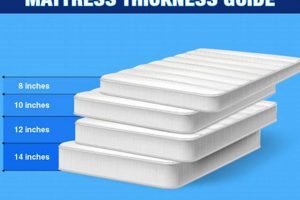
![Choosing: Heated Blanket vs Mattress Pad? [Guide] Organic & Natural Mattress Buyer’s Guide: Non-Toxic Sleep Solutions Choosing: Heated Blanket vs Mattress Pad? [Guide] | Organic & Natural Mattress Buyer’s Guide: Non-Toxic Sleep Solutions](https://mattressworldpa.com/wp-content/uploads/2025/07/th-1033-300x200.jpg)
